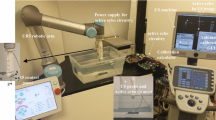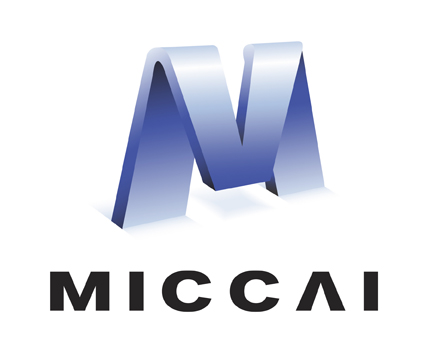Abstract
We propose a novel method to automatically calibrate tracked ultrasound probes. To this end we design a custom phantom consisting of nine cones with different heights. The tips are used as key points to be matched between multiple sweeps. We extract them using a convolutional neural network to segment the cones in every ultrasound frame and then track them across the sweep. The calibration is robustly estimated using RANSAC and later refined employing image based techniques. Our phantom can be 3D-printed and offers many advantages over state-of-the-art methods. The phantom design and algorithm code are freely available online. Since our phantom does not require a tracking target on itself, ease of use is improved over currently used techniques. The fully automatic method generalizes to new probes and different vendors, as shown in our experiments. Our approach produces results comparable to calibrations obtained by a domain expert.
Access this chapter
Tax calculation will be finalised at checkout
Purchases are for personal use only
Similar content being viewed by others
References
Barratt, D.C., Davies, A.H., Hughes, A.D., Thom, S.A., Humphries, K.N.: Accuracy of an electromagnetic three-dimensional ultrasound system for carotid artery imaging. Ultrasound Med. Biol. 27(10), 1421–1425 (2001)
Carbajal, G., Lasso, A., Gómez, Á., Fichtinger, G.: Improving n-wire phantom-based freehand ultrasound calibration. Int. J. Comput. Assist. Radiol. Surg. 8(6), 1063–1072 (2013)
Chatrasingh, M., Suthakorn, J.: A novel design of N-fiducial phantom for automatic ultrasound calibration. J. Med. Phys. 44(3), 191 (2019). http://www.jmp.org.in/text.asp?2019/44/3/191/266852
Chen, E.C., Lasso, A., Fichtinger, G.: External tracking devices and tracked tool calibration. In: Handbook of Medical Image Computing and Computer Assisted Intervention, pp. 777–794. Elsevier (2020)
Chen, T.K., Thurston, A.D., Ellis, R.E., Abolmaesumi, P.: A real-time freehand ultrasound calibration system with automatic accuracy feedback and control. Ultrasound Med. Biol. 35(1), 79–93 (2009). https://doi.org/10.1016/j.ultrasmedbio.2008.07.004, https://linkinghub.elsevier.com/retrieve/pii/S0301562908003190
Cheng, A., Guo, X., Zhang, H.K., Kang, H.J., Etienne-Cummings, R., Boctor, E.M.: Active phantoms: a paradigm for ultrasound calibration using phantom feedback. J. Med. Imaging 4(3), 035001 (2017)
Dandekar, S., Li, Y., Molloy, J., Hossack, J.: A phantom with reduced complexity for spatial 3-D ultrasound calibration. Ultrasound Med. Biol. 31(8), 1083–1093 (2005)
Detmer, P.R., et al.: 3D ultrasonic image feature localization based on magnetic scanhead tracking: in vitro calibration and validation. Ultrasound Med. Biol. 20(9), 923–936 (1994)
DeVries, T., Taylor, G.W.: Improved regularization of convolutional neural networks with cutout. arXiv preprint arXiv:1708.04552 (2017)
Fischler, M., Bolles, R.: Random sample consensus: a paradigm for model fitting with applications to image analysis and automated cartography. Commun. ACM 24(6), 381–395 (1981)
Fukushima, K.: Neural network model for a mechanism of pattern recognition unaffected by shift in position-neocognitron. IEICE Tech. Rep. A 62(10), 658–665 (1979)
Fukushima, K.: A self-organizing neural network model for a mechanism of pattern recognition unaffected by shift in position. Biol. Cybern. 36, 193–202 (1980)
He, K., Zhang, X., Ren, S., Sun, J.: Deep residual learning for image recognition. In: Proceedings of the IEEE Conference on Computer Vision and Pattern Recognition, pp. 770–778 (2016)
Higham, N.J.: Matrix nearness problems and applications. In: Gover, M.J.C., Barnett, S. (eds.) Applications of Matrix Theory, pp. 1–27. Oxford University Press, Oxford (1989)
Hsu, P.W., Prager, R.W., Gee, A.H., Treece, G.M.: Freehand 3D ultrasound calibration: a review. Adv. Imaging Biol. Med. 47–84 (2009). https://doi.org/10.1007/978-3-540-68993-5_3
Krupa, A.: Automatic calibration of a robotized 3D ultrasound imaging system by visual servoing. In: Proceedings 2006 IEEE International Conference on Robotics and Automation, 2006. ICRA 2006, pp. 4136–4141. IEEE (2006)
Lecun, Y., Bottou, L., Bengio, Y., Haffner, P.: Gradient-based learning applied to document recognition. P. IEEE 86(11), 2278–2324 (1998)
Maas, A.L., Hannun, A.Y., Ng, A.Y.: Rectifier nonlinearities improve neural network acoustic models. In: Proceedings ICML, vol. 30, p. 3. Citeseer (2013)
Meairs, S., Beyer, J., Hennerici, M.: Reconstruction and visualization of irregularly sampled three-and four-dimensional ultrasound data for cerebrovascular applications. Ultrasound Med. Biol. 26(2), 263–272 (2000)
Mercier, L., Langø, T., Lindseth, F., Collins, D.L.: A review of calibration techniques for freehand 3-D ultrasound systems. Ultrasound Med. Biol. 31(4), 449–471 (2005)
Muratore, D.M., Galloway, R.L., Jr.: Beam calibration without a phantom for creating a 3-D freehand ultrasound system. Ultrasound Med. Biol. 27(11), 1557–1566 (2001)
Ronneberger, O., Fischer, P., Brox, T.: U-Net: convolutional networks for biomedical image segmentation. In: Navab, N., Hornegger, J., Wells, W.M., Frangi, A.F. (eds.) MICCAI 2015. LNCS, vol. 9351, pp. 234–241. Springer, Cham (2015). https://doi.org/10.1007/978-3-319-24574-4_28
Shen, C., Lyu, L., Wang, G., Wu, J.: A method for ultrasound probe calibration based on arbitrary wire phantom. Cogent Eng. 6(1), 1592739 (2019)
Ulyanov, D., Vedaldi, A., Lempitsky, V.: Instance normalization: the missing ingredient for fast stylization. arXiv preprint arXiv:1607.08022 (2016)
Viswanathan, A., Boctor, E.M., Taylor, R.H., Hager, G., Fichtinger, G.: Immediate ultrasound calibration with three poses and minimal image processing. In: Barillot, C., Haynor, D.R., Hellier, P. (eds.) MICCAI 2004. LNCS, vol. 3217, pp. 446–454. Springer, Heidelberg (2004). https://doi.org/10.1007/978-3-540-30136-3_55
Wein, W., Khamene, A.: Image-based method for in-vivo freehand ultrasound calibration. In: Medical Imaging 2008: Ultrasonic Imaging and Signal Processing, vol. 6920, pp. 179–185. SPIE (2008)
Wen, T., Wang, C., Zhang, Y., Zhou, S.: A novel ultrasound probe spatial calibration method using a combined phantom and stylus. Ultrasound Med. Biol. 46(8), 2079–2089 (2020)
Xiao, Y., Yan, C.X.B., Drouin, S., De Nigris, D., Kochanowska, A., Collins, D.L.: User-friendly freehand ultrasound calibration using Lego bricks and automatic registration. Int. J. Comput. Assist. Radiol. Surg. 11(9), 1703–1711 (2016)
Acknowledgment
This work was partially funded by the German Federal Ministry of Education and Research (BMBF), grant 13GW0293B (“FOMIPU”).
Author information
Authors and Affiliations
Corresponding author
Editor information
Editors and Affiliations
Rights and permissions
Copyright information
© 2022 The Author(s), under exclusive license to Springer Nature Switzerland AG
About this paper
Cite this paper
Ronchetti, M. et al. (2022). PRO-TIP: Phantom for RObust Automatic Ultrasound Calibration by TIP Detection. In: Wang, L., Dou, Q., Fletcher, P.T., Speidel, S., Li, S. (eds) Medical Image Computing and Computer Assisted Intervention – MICCAI 2022. MICCAI 2022. Lecture Notes in Computer Science, vol 13437. Springer, Cham. https://doi.org/10.1007/978-3-031-16449-1_9
Download citation
DOI: https://doi.org/10.1007/978-3-031-16449-1_9
Published:
Publisher Name: Springer, Cham
Print ISBN: 978-3-031-16448-4
Online ISBN: 978-3-031-16449-1
eBook Packages: Computer ScienceComputer Science (R0)





